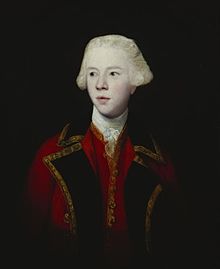George Howe, 3rd Viscount Howe
| George Augustus Howe, 3rd Viscount Howe | |
|---|---|

George Augustus, 3rd Viscount Howe, Half-Length, Wearing the Uniform of the 1st Guard, by Sir Joshua Reynolds
|
|
| Born | c.1725 |
| Died | 6 July 1758 |
| Allegiance |
|
| Service/branch | British Army |
| Rank | Brigadier General |
George Augustus Howe, 3rd Viscount Howe (c. 1725 – 6 July 1758) was a career officer and a Brigadier General in the British Army. He was described by James Wolfe as "the best officer in the British Army". He was killed in the French and Indian War in a skirmish the day before the Battle of Carillon, an ultimately disastrous attempt by the British to capture French-controlled Fort Carillon.
Howe's father was Emanuel Scrope Howe, 2nd Viscount Howe, and mother was Mary Sophia von Kielmansegg (A niece of King George I), and he had two notable younger brothers, Richard Howe, Earl Howe and William Howe, 5th Viscount Howe, as well as seven other siblings. George was born either on the Howe estate at Langar, Nottinghamshire, or at the Howe home on Albemarle Street, London.
Howe joined the army as an Ensign of the 1st Foot Guards in 1745 and saw service during the Flanders campaign of the War of the Austrian Succession. In 1746 he was made an aide-de-camp to the Duke of Cumberland who led the Allied Army in Flanders. In 1747 Howe fought at the Battle of Laufeld. He was promoted to Lieutenant Colonel in 1749 following the end of the war.
...
Wikipedia
